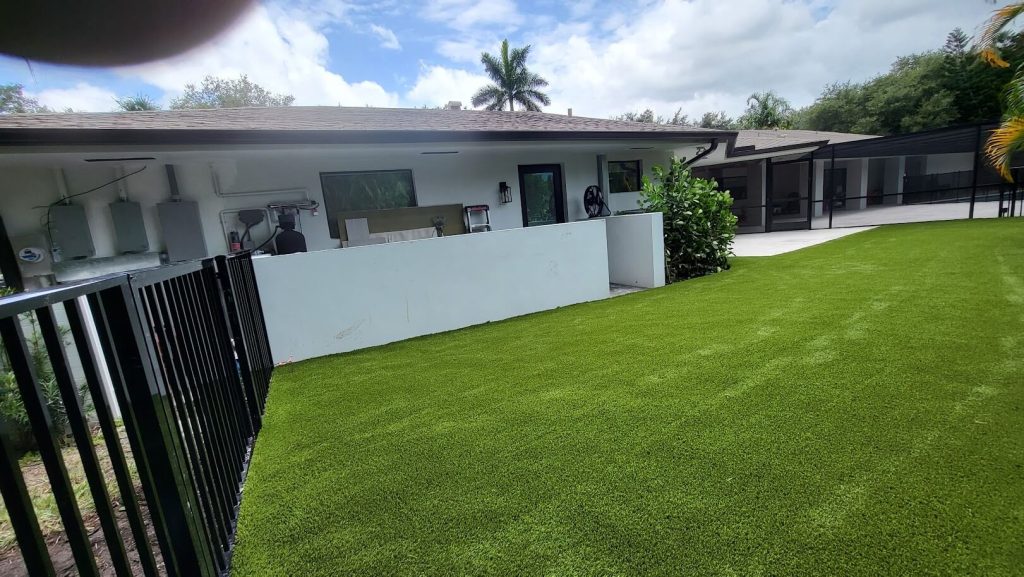
Key Takeaways
- Low Maintenance: Artificial turf requires minimal upkeep compared to natural grass, saving time and resources.
- Durability: It is resistant to pests, disease, and does not need watering, mowing, or fertilizing.
- Preparation is Key: Proper preparation of the lawn area, including removal of existing grass and leveling the base, is crucial for a successful installation.
- Installation Steps: Laying, securing, and adding infill to the artificial turf ensures a stable and natural-looking lawn.
- Consider Alternatives: While beneficial, artificial turf might not be suitable for everyone. Consider the pros and cons before deciding.
Are you tired of the endless maintenance that comes with a natural lawn? Imagine a lush, green lawn that requires minimal upkeep and stays perfect all year round.
Artificial turf has become an increasingly popular solution for homeowners seeking a beautiful, low-maintenance lawn. In this guide, we’ll walk you through the process of installing artificial turf yourself, offering tips and insights to help you achieve a flawless lawn with minimal hassle.
The Benefits of Artificial Turf
Before diving into the installation process, it’s essential to understand why artificial turf might be a great choice for your yard. Unlike natural grass, artificial turf does not need regular watering, mowing, or fertilizing.
It is also resistant to pests and disease, making it a practical option for busy homeowners. With advancements in technology, modern artificial turf closely mimics the look and feel of natural grass, providing a visually appealing and functional alternative.
Preparing Your Lawn for Installation
- Assess Your Space
Start by evaluating the area where you plan to install the artificial turf. Measure the dimensions to determine how much turf you’ll need and identify any obstacles such as trees, shrubs, or garden beds that may require adjustments during installation.
- Remove Existing Grass
Next, you’ll need to remove the existing grass and vegetation. This can be done using a shovel or a sod cutter. Ensure you remove all roots and debris to create a clean, level surface for the turf. If you have a large area, consider renting equipment to speed up the process.
- Prepare the Base
A well-prepared base is crucial for a successful artificial turf installation. Start by leveling the area and adding a layer of crushed stone or gravel to create a stable foundation.
Compact the base thoroughly to prevent any shifting or settling over time. A geotextile fabric can also be laid down to prevent weed growth and improve drainage.
Installing Artificial Turf
- Lay the Turf
Once your base is ready, it’s time to lay the artificial turf. Unroll the turf over the prepared area, ensuring that the edges are aligned properly.
Cut the turf to fit around any obstacles, and make sure there are no gaps or overlaps. If you’re working with multiple pieces, join them together using seam tape or adhesive, following the manufacturer’s instructions.
- Secure the Turf
To keep the turf in place, secure it using landscape staples or nails. Place these fasteners around the edges and throughout the field to ensure that the turf remains anchored and does not shift.
Be careful not to place the fasteners too close to the edges, as this can cause the turf to pull away.
- Add Infill
Infill material, such as rubber or sand, is often added to artificial turf to help it stand upright and provide additional cushioning. Spread the infill evenly across the surface and use a broom or rake to work it into the turf fibers. This step helps to keep the grass looking natural and improves its durability.
Maintenance and Care
One of the significant advantages of artificial turf is its low maintenance. Regular brushing will help keep the fibers upright and remove any debris.
Occasionally rinse the turf with water to wash away dust and dirt. If you have pets, clean up any waste promptly to maintain hygiene.
Considerations and Alternatives
While artificial turf offers many benefits, it’s not the perfect solution for everyone. Some people may prefer the natural look and feel of real grass or may have concerns about the environmental impact of synthetic materials. Consider your specific needs and preferences before making a decision.
If you’re considering transforming your lawn with artificial turf, look no further than Ben Turf Landscaping. Located in beautiful Boca Raton, FL, Ben Turf Landscaping offers expert services to help you achieve a lush, green lawn with minimal upkeep.
You can reach out to them at (954) 932-7769 for more information and to get started on your lawn transformation today!
Conclusion
Installing artificial turf yourself can be a rewarding project that results in a stunning, maintenance-free lawn. By following these steps and paying attention to detail, you can achieve a professional-looking installation that enhances the beauty and functionality of your outdoor space.
Ready to transform your lawn with do it yourself artificial turf? Contact Ben Turf Landscaping to get started!
FAQs
Q: Why should I choose artificial turf over natural grass?
A: Artificial turf is low maintenance, durable, and resistant to pests and diseases, making it a practical option for busy homeowners.
Q: How do I prepare my lawn for artificial turf installation?
A: Start by assessing your space, removing existing grass, and preparing a stable base with crushed stone or gravel.
Q: Can I install artificial turf myself?
A: Yes, with proper preparation and following the installation steps, you can achieve a professional-looking artificial turf installation.

